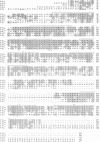Abstract
The serotonin 1D (5-HT1D) receptor is a pharmacologically defined binding site and functional receptor site. Observed variations in the properties of 5-HT1D receptors in different tissues have led to the speculation that multiple receptor proteins with slightly different properties may exist. We report here the cloning, deduced amino acid sequences, pharmacological properties, and second-messenger coupling of a pair of human 5-HT1D receptor genes, which we have designated 5-HT1D alpha and 5-HT1D beta due to their strong similarities in sequence, pharmacological properties, and second-messenger coupling. Both genes are free of introns in their coding regions, are expressed in the human cerebral cortex, and can couple to inhibition of adenylate cyclase activity. The pharmacological binding properties of these two human receptors are very similar, and match closely the pharmacological properties of human, bovine, and guinea pig 5-HT1D sites. Both receptors exhibit high-affinity binding of sumatriptan, a new anti-migraine medication, and thus are candidates for the pharmacological site of action of this drug.
Full text
PDF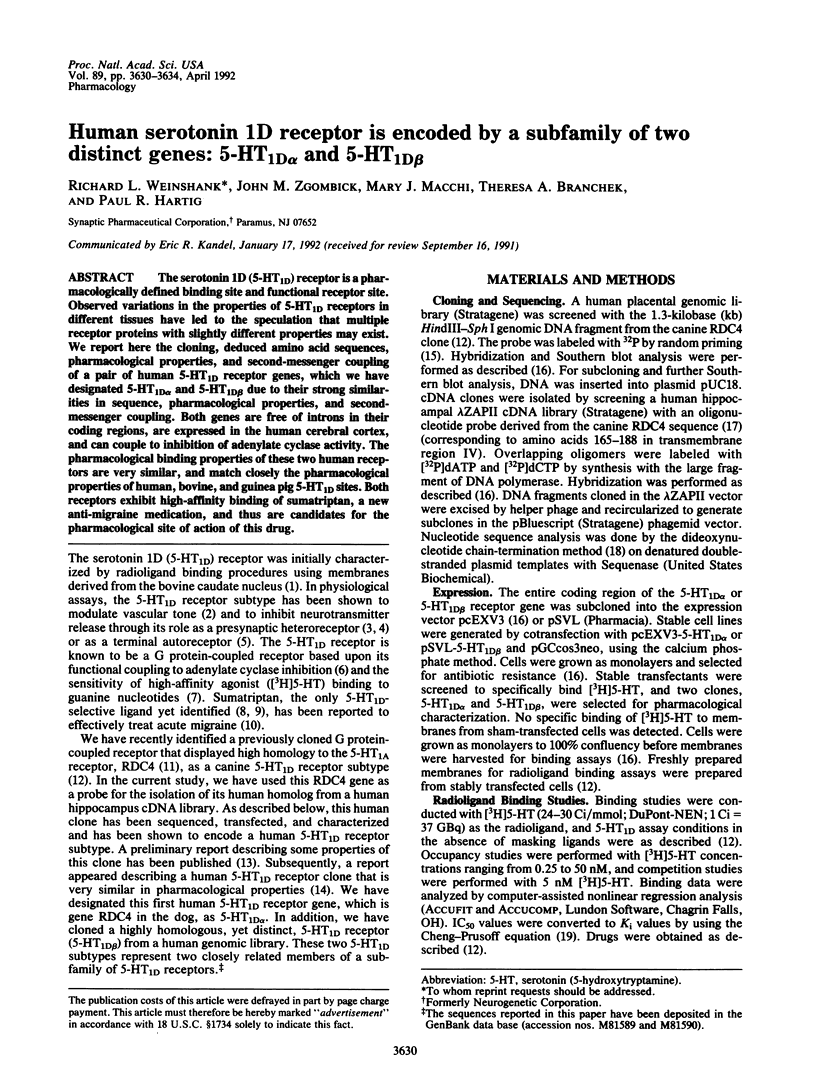
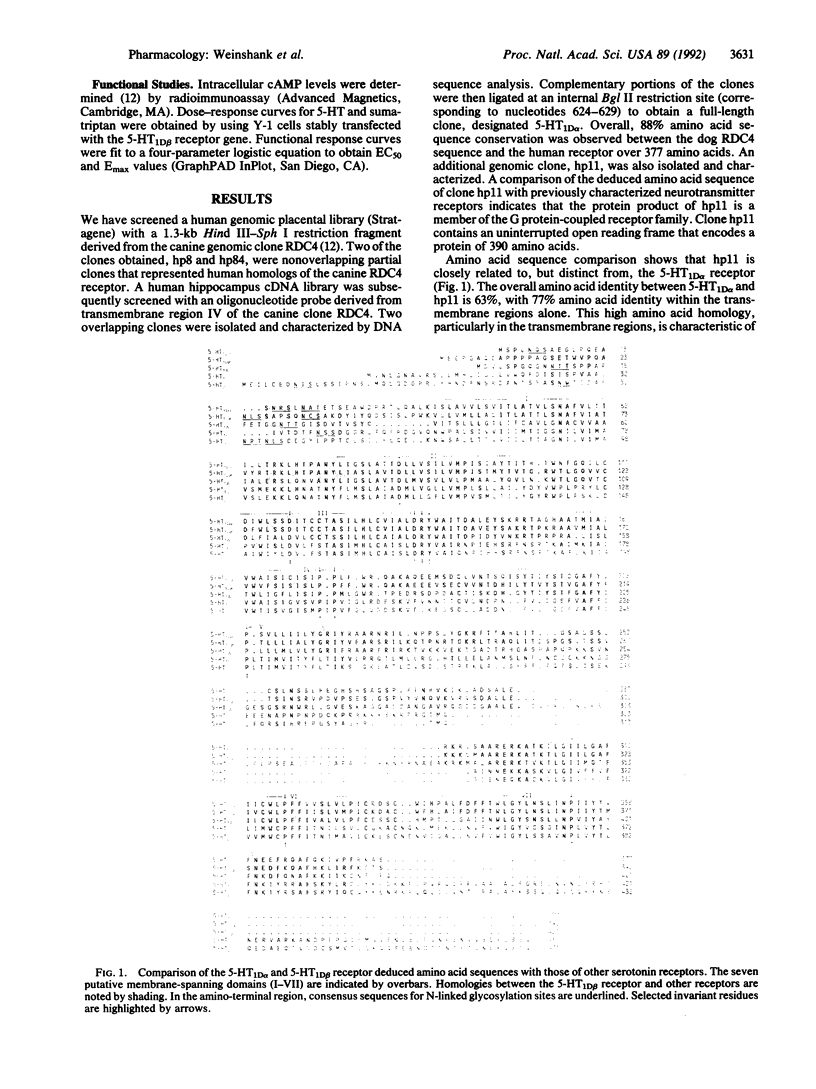
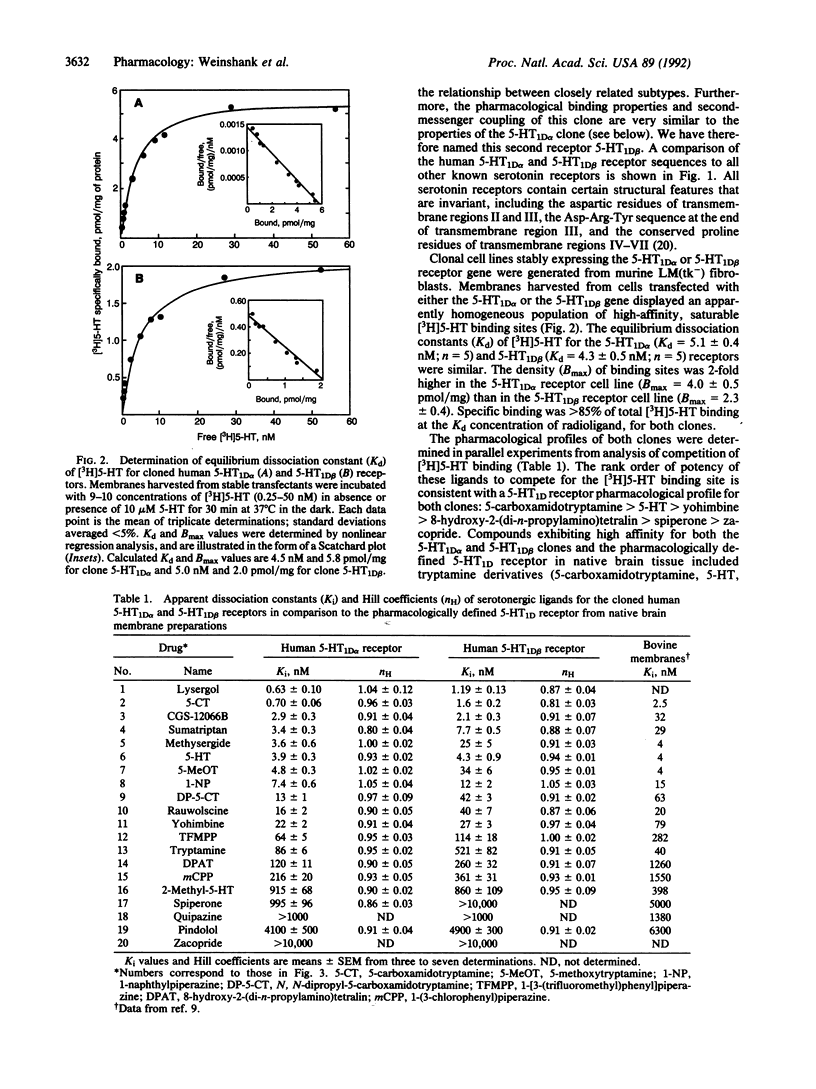
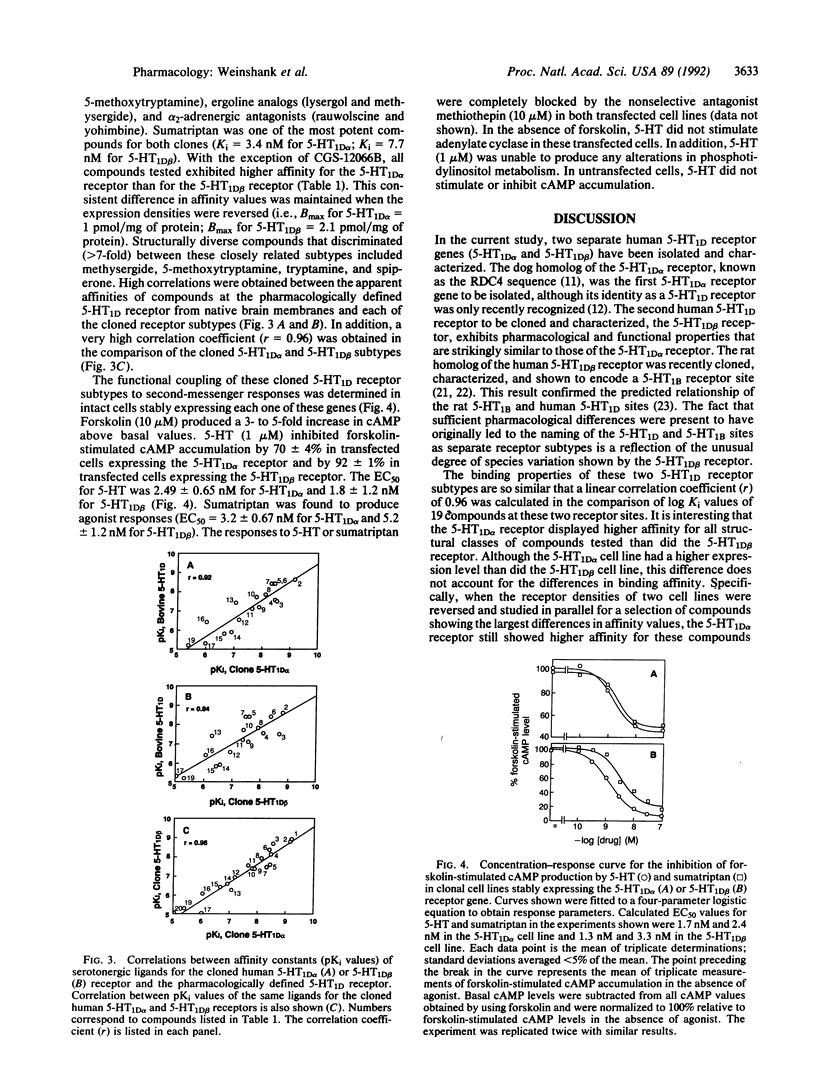
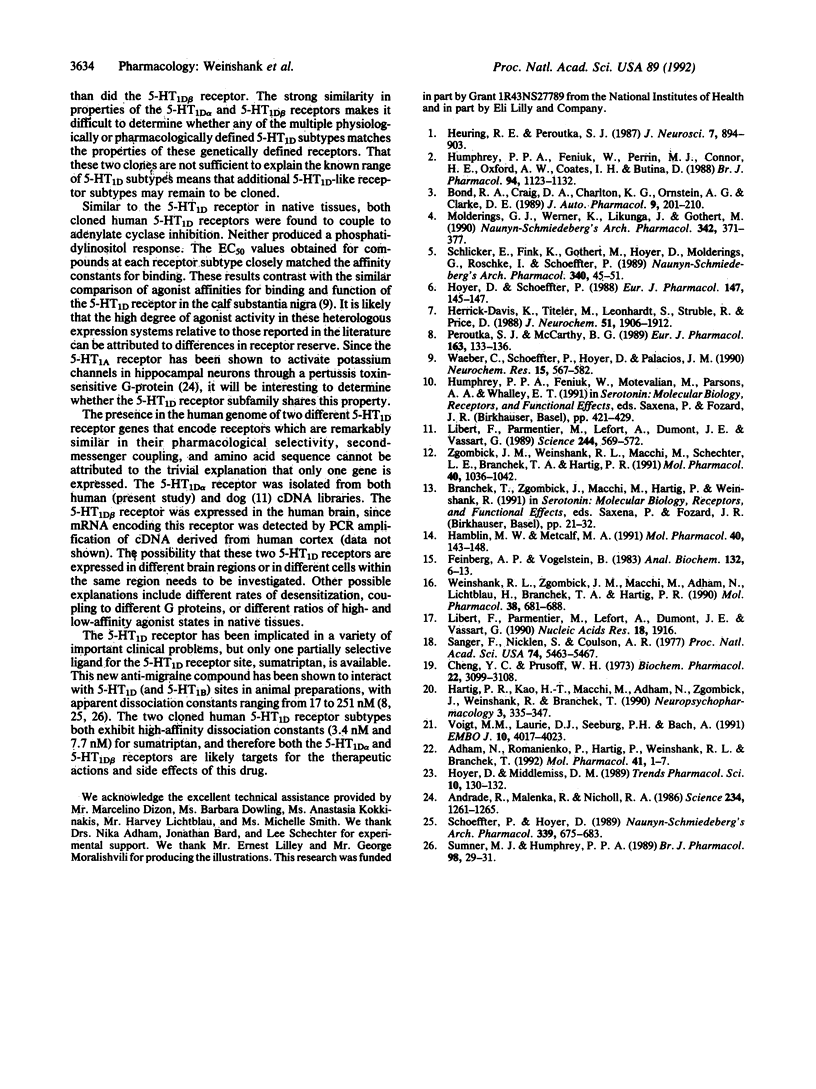
Images in this article
Selected References
These references are in PubMed. This may not be the complete list of references from this article.
- Adham N., Romanienko P., Hartig P., Weinshank R. L., Branchek T. The rat 5-hydroxytryptamine1B receptor is the species homologue of the human 5-hydroxytryptamine1D beta receptor. Mol Pharmacol. 1992 Jan;41(1):1–7. [PubMed] [Google Scholar]
- Andrade R., Malenka R. C., Nicoll R. A. A G protein couples serotonin and GABAB receptors to the same channels in hippocampus. Science. 1986 Dec 5;234(4781):1261–1265. doi: 10.1126/science.2430334. [DOI] [PubMed] [Google Scholar]
- Bond R. A., Craig D. A., Charlton K. G., Ornstein A. G., Clarke D. E. Partial agonistic activity of GR43175 at the inhibitory prejunctional 5-HT1-like receptor in rat kidney. J Auton Pharmacol. 1989 Jun;9(3):201–210. doi: 10.1111/j.1474-8673.1989.tb00211.x. [DOI] [PubMed] [Google Scholar]
- Cheng Y., Prusoff W. H. Relationship between the inhibition constant (K1) and the concentration of inhibitor which causes 50 per cent inhibition (I50) of an enzymatic reaction. Biochem Pharmacol. 1973 Dec 1;22(23):3099–3108. doi: 10.1016/0006-2952(73)90196-2. [DOI] [PubMed] [Google Scholar]
- Feinberg A. P., Vogelstein B. A technique for radiolabeling DNA restriction endonuclease fragments to high specific activity. Anal Biochem. 1983 Jul 1;132(1):6–13. doi: 10.1016/0003-2697(83)90418-9. [DOI] [PubMed] [Google Scholar]
- Hamblin M. W., Metcalf M. A. Primary structure and functional characterization of a human 5-HT1D-type serotonin receptor. Mol Pharmacol. 1991 Aug;40(2):143–148. [PubMed] [Google Scholar]
- Hartig P., Kao H. T., Macchi M., Adham N., Zgombick J., Weinshank R., Branchek T. The molecular biology of serotonin receptors. An overview. Neuropsychopharmacology. 1990 Oct-Dec;3(5-6):335–347. [PubMed] [Google Scholar]
- Herrick-Davis K., Titeler M., Leonhardt S., Struble R., Price D. Serotonin 5-HT1D receptors in human prefrontal cortex and caudate: interaction with a GTP binding protein. J Neurochem. 1988 Dec;51(6):1906–1912. doi: 10.1111/j.1471-4159.1988.tb01176.x. [DOI] [PubMed] [Google Scholar]
- Heuring R. E., Peroutka S. J. Characterization of a novel 3H-5-hydroxytryptamine binding site subtype in bovine brain membranes. J Neurosci. 1987 Mar;7(3):894–903. doi: 10.1523/JNEUROSCI.07-03-00894.1987. [DOI] [PMC free article] [PubMed] [Google Scholar]
- Hoyer D., Middlemiss D. N. Species differences in the pharmacology of terminal 5-HT autoreceptors in mammalian brain. Trends Pharmacol Sci. 1989 Apr;10(4):130–132. doi: 10.1016/0165-6147(89)90159-4. [DOI] [PubMed] [Google Scholar]
- Hoyer D., Schoeffter P. 5-HT1D receptor-mediated inhibition of forskolin-stimulated adenylate cyclase activity in calf substantia nigra. Eur J Pharmacol. 1988 Feb 16;147(1):145–147. doi: 10.1016/0014-2999(88)90645-0. [DOI] [PubMed] [Google Scholar]
- Humphrey P. P., Feniuk W., Perren M. J., Connor H. E., Oxford A. W., Coates L. H., Butina D. GR43175, a selective agonist for the 5-HT1-like receptor in dog isolated saphenous vein. Br J Pharmacol. 1988 Aug;94(4):1123–1132. doi: 10.1111/j.1476-5381.1988.tb11630.x. [DOI] [PMC free article] [PubMed] [Google Scholar]
- Libert F., Parmentier M., Lefort A., Dinsart C., Van Sande J., Maenhaut C., Simons M. J., Dumont J. E., Vassart G. Selective amplification and cloning of four new members of the G protein-coupled receptor family. Science. 1989 May 5;244(4904):569–572. doi: 10.1126/science.2541503. [DOI] [PubMed] [Google Scholar]
- Libert F., Parmentier M., Lefort A., Dumont J. E., Vassart G. Complete nucleotide sequence of a putative G protein coupled receptor: RDC4. Nucleic Acids Res. 1990 Apr 11;18(7):1916–1916. doi: 10.1093/nar/18.7.1916. [DOI] [PMC free article] [PubMed] [Google Scholar]
- Molderings G. J., Werner K., Likungu J., Göthert M. Inhibition of noradrenaline release from the sympathetic nerves of the human saphenous vein via presynaptic 5-HT receptors similar to the 5-HT 1D subtype. Naunyn Schmiedebergs Arch Pharmacol. 1990 Oct;342(4):371–377. doi: 10.1007/BF00169451. [DOI] [PubMed] [Google Scholar]
- Peroutka S. J., McCarthy B. G. Sumatriptan (GR 43175) interacts selectively with 5-HT1B and 5-HT1D binding sites. Eur J Pharmacol. 1989 Apr 12;163(1):133–136. doi: 10.1016/0014-2999(89)90406-8. [DOI] [PubMed] [Google Scholar]
- Sanger F., Nicklen S., Coulson A. R. DNA sequencing with chain-terminating inhibitors. Proc Natl Acad Sci U S A. 1977 Dec;74(12):5463–5467. doi: 10.1073/pnas.74.12.5463. [DOI] [PMC free article] [PubMed] [Google Scholar]
- Schlicker E., Fink K., Göthert M., Hoyer D., Molderings G., Roschke I., Schoeffter P. The pharmacological properties of the presynaptic serotonin autoreceptor in the pig brain cortex conform to the 5-HT1D receptor subtype. Naunyn Schmiedebergs Arch Pharmacol. 1989 Jul;340(1):45–51. doi: 10.1007/BF00169206. [DOI] [PubMed] [Google Scholar]
- Schoeffter P., Hoyer D. Interaction of arylpiperazines with 5-HT1A, 5-HT1B, 5-HT1C and 5-HT1D receptors: do discriminatory 5-HT1B receptor ligands exist? Naunyn Schmiedebergs Arch Pharmacol. 1989 Jun;339(6):675–683. doi: 10.1007/BF00168661. [DOI] [PubMed] [Google Scholar]
- Sumner M. J., Humphrey P. P. 5-HT1D binding sites in porcine brain can be sub-divided by GR43175. Br J Pharmacol. 1989 Sep;98(1):29–31. doi: 10.1111/j.1476-5381.1989.tb16856.x. [DOI] [PMC free article] [PubMed] [Google Scholar]
- Voigt M. M., Laurie D. J., Seeburg P. H., Bach A. Molecular cloning and characterization of a rat brain cDNA encoding a 5-hydroxytryptamine1B receptor. EMBO J. 1991 Dec;10(13):4017–4023. doi: 10.1002/j.1460-2075.1991.tb04977.x. [DOI] [PMC free article] [PubMed] [Google Scholar]
- Waeber C., Schoeffter P., Hoyer D., Palacios J. M. The serotonin 5-HT1D receptor: a progress review. Neurochem Res. 1990 Jun;15(6):567–582. doi: 10.1007/BF00973745. [DOI] [PubMed] [Google Scholar]
- Weinshank R. L., Zgombick J. M., Macchi M., Adham N., Lichtblau H., Branchek T. A., Hartig P. R. Cloning, expression, and pharmacological characterization of a human alpha 2B-adrenergic receptor. Mol Pharmacol. 1990 Nov;38(5):681–688. [PubMed] [Google Scholar]
- Zgombick J. M., Weinshank R. L., Macchi M., Schechter L. E., Branchek T. A., Hartig P. R. Expression and pharmacological characterization of a canine 5-hydroxytryptamine1D receptor subtype. Mol Pharmacol. 1991 Dec;40(6):1036–1042. [PubMed] [Google Scholar]



